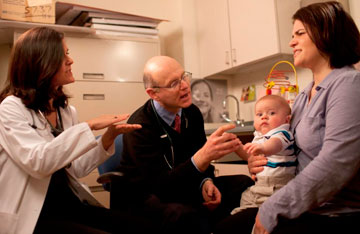To read part 2 of this series, “Early Intervention is Key,” click here

Part Three: 800 Gallons of Coke
Some risk factors for obesity, such as less breast-feeding, are specific to infants. Others, however, are present throughout a child’s life. Sugary cereals, oversized soft drinks, and quarter-pound cheeseburgers: They’re just a few of the unhealthy food choices kids face every day.
There’s no question that junk food, most of which is highly processed, and sugar-sweetened beverages are major contributors to the U.S. childhood obesity epidemic.
“In this case,” says Walter Willett, HMS professor of medicine and chair of the Harvard School of Public Health’s Department of Nutrition, “the 800-gallon can of Coke in the room really is the 800-gallon can of Coke in the room.”
There’s no lack of convincing research—much of it conducted at HMS and the Harvard School of Public Health—demonstrating the solid relationship between such fare and a greater risk of obesity. A well-publicized 2001 study by David Ludwig, an HMS professor of pediatrics and director of the New Balance Foundation Obesity Prevention Center Boston Children’s Hospital, and colleagues found that for each additional serving of sugar-sweetened beverage that a child consumes, his or her risk of obesity increases by 1.6 times.
More recently, Ludwig’s research has shown that overweight teens tend to eat more fast food than their leaner peers, putting them at higher risk for insulin resistance and type 2 diabetes down the road. As founder and director of the Children’s Optimal Weight for Life (OWL) Program—a multidisciplinary care clinic dedicated to the evaluation and treatment of children who are overweight and obese—Ludwig is applying his research findings to the real world.
One key tool in that quest: advertising, primarily via television commercials.
“These companies are investing billions of dollars into marketing campaigns designed to get kids to eat the poorest food imaginable,” adds Ludwig. “It’s clear that children are their main targets. Just look at the ads during Saturday morning cartoons.”
This approach is succeeding: Ludwig and his colleagues from the Harvard School of Public Health have shown that every hour of TV a child watches is associated with the consumption of an extra 167 calories, particularly in form of fast food, salty snacks and sugar-sweetened beverages.
“There’s no real mystery here,” says Willett. “In some ways, the obesity epidemic is the inevitable consequence of our capitalistic food supply. Food and beverage companies are competing with each other to get people to buy their products—and they work hard to make those unhealthy products even more seductive to kids.”
Television can have additional, less obvious effects on a child’s weight, too, says Matthew Gillman, professor and director of the Obesity Prevention Program in the HMS Department of Population Medicine.
“We’re finding that TV watching doesn’t just replace physical activity,” he explains. “Screen time is also displacing sleep, starting early in life, and this is certainly a problem for today’s older kids and adolescents.” Indeed, studies suggest that children who have a TV in their bedroom are more likely to be overweight and obese. Factor in the effects of a sedentary lifestyle, and you’ve got a potent recipe for obesity.
Looking Forward
It’s impossible to visit a school—or a day care center, for that matter—and doubt that the United States is in the middle of a childhood obesity crisis. Yet, even if parents, pediatricians and other experts are doing all that they can to keep kids healthy, they’re faced with a seemingly impossible battle against so-called Big Food.
“But we have a real opportunity here,” says Ludwig, who likens childhood obesity to the fight against tobacco companies. “There were years of debate about the role personal responsibility plays in tobacco-related illness, but that argument couldn’t apply to people who breathe secondhand smoke because they never agreed to accept that risk.”
Likewise, adults may choose to eat unhealthy food, but children cannot.
“Kids lack the cognitive ability to defend themselves against manipulation by food and beverage marketers,” he explains. “Once we recognize that, we’ll shift the debate and better be able to fight marketers of junk food the same way we did with tobacco.”
Many researchers believe a true prescription for obesity should cover all aspects of a child’s life:
Society. Schools must receive better funding for physical education classes and recess, while city planning boards should address the lack of outdoor activity space in many communities.
Government. Congress, the Food and Drug Administration and the Federal Trade Commission should collaborate on ways to regulate food marketing aimed at children, and the government needs to better align public spending with public health by revamping the Farm Bill, which fails to subsidize healthy choices such as fruits and vegetables.
Physicians.Doctors must recognize that childhood obesity is one of today’s most prevalent chronic diseases and make it a bigger part of primary care. Physicians can also band together with public health advocates, legal and business experts, researchers and parents to fight childhood obesity.
Such changes can make a big difference for kids, even if they’re already overweight or obese, says Ludwig. This hopeful attitude is at the core of Harvard researchers’ efforts to wipe out the disease—and is the driving force behind Harvard Catalyst’s challenge.
“Our community is filled with people who walk the talk when it comes to wanting to eliminate childhood obesity,” says Lee Nadler. “I really believe that we can make this happen.”
Back in Dorchester, Tiarra Francis is at the playground. Thanks to advice from Elsie Taveras and hard work by her parents, she’s lost weight, is watching less TV and is more physically active.
“I tell her, we don’t say can’t,” says her mother as Tiarra plays nearby. “If one person has done it, you can do it, too. I’m involved, and I want to educate my daughter.”
To watch the entire Weight of the Nation series, visit http://theweightofthenation.hbo.com. For more information on grant opportunities for childhood obesity research, visit http://catalyst.harvard.edu/.


